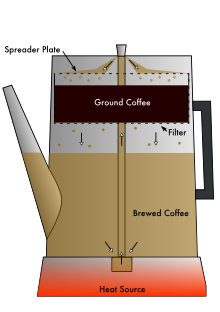Hyper Text Coffee Pot Control Protocol
This article's tone or style may not reflect the encyclopedic tone used on Wikipedia. |
This article provides insufficient context for those unfamiliar with the subject. |

The Hyper Text Coffee Pot Control Protocol (HTCPCP for short) is a protocol for controlling, monitoring, and diagnosing coffee pots.
HTCPCP is specified in RFC 2324, published on 1 April 1998.[1] The editor Emacs includes a fully functional implementation of it,[2] and a number of bug reports exist complaining about Mozilla's lack of support for the protocol.[3] Ten years after the publication of HTCPCP, the Web-Controlled Coffee Consortium (WC3) published a first draft of "HTCPCP Vocabulary in RDF"[4] in analogy of the World Wide Web Consortium's (W3C) "HTTP Vocabulary in RDF".[5]
Commands and replies
HTCPCP is an extension of HTTP. HTCPCP requests are identified with the URI scheme coffee: (or the corresponding word in any other of the 29 listed languages) and contain several additions to the HTTP methods:
BREW or POST |
Causes the HTCPCP server to brew coffee |
GET |
Retrieves coffee from the HTCPCP server |
PROPFIND |
Finds out metadata about the coffee |
WHEN |
Says "when", causing the HTCPCP server to stop pouring milk into the coffee (if applicable) |
It also defines two error responses:
406 Not Acceptable |
The HTCPCP server is unable to brew coffee for some reason; the response should indicate a list of acceptable coffee types. |
418 I'm a teapot |
The HTCPCP server is a teapot; the resulting entity may be short and stout. Demonstrations of this behaviour exist.[6][7][8][9] |
See also
References
- ^ Network Working Group – Request for Comments: 2324
- ^ Emacs extension: coffee.el
- ^ Bug 46647 – (coffeehandler) HTCPCP not supported (RFC2324) at bugzilla.mozilla.org
- ^ Chief Arabica (Web-Controlled Coffee Consortium): HTCPCP Vocabulary in RDF – WC3 RFC Draft 01 April 2008. Accessed 17 August 2009.
- ^ Johannes Koch et al (editors): "HTTP Vocabulary in RDF". Accessed 17 August 2009.
- ^ HTTP 418 implemented on BBC CBeebies
- ^ HTTP 418 implemented on The New York Times
- ^ Implementing Error 418
- ^ Error 418 implemented
